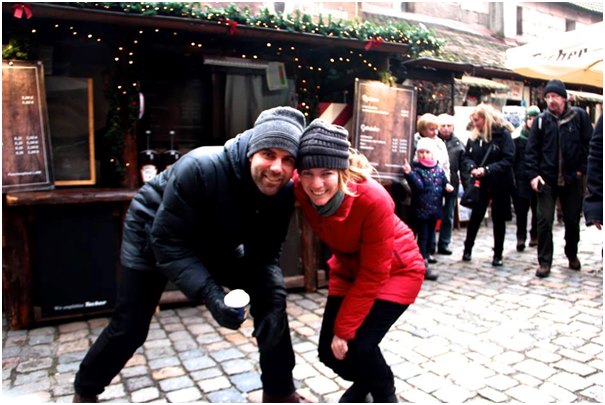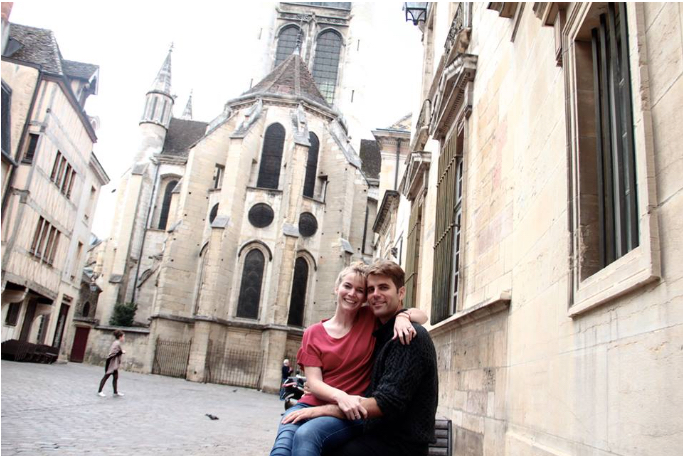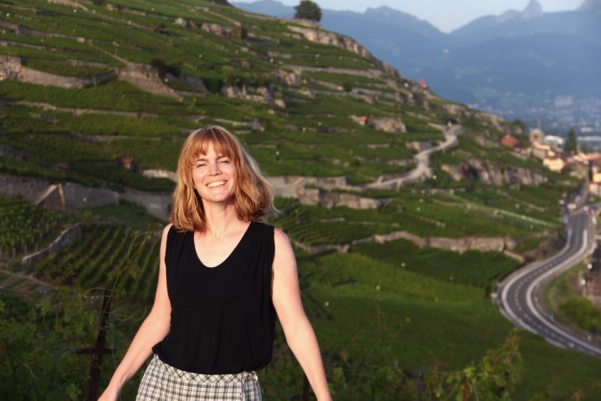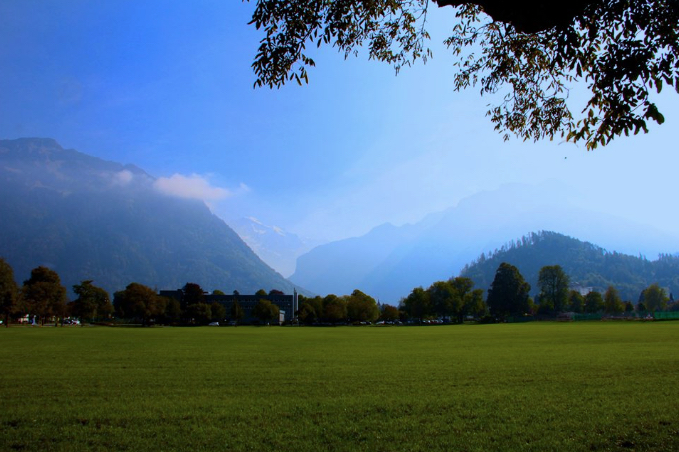Souvenirs from Switzerland: Our Exchange Year in Bern

BY MARTIN PINCKNEY
Part 1: Feeling the Bern
My arrival in Bern was not as I had pictured it. My family had just finished our vacation in Greece–monumental in that it was the first we had spent overseas. It was to be a Summer of transitions and uncertain outcomes for most of us, and so the tiny Greek island where they stay up all night and put on regular saint-day village festivals seemed like the perfect place to wait out the future (in truth it had been my mother’s lifelong dream to go). The year-long masters exchange at the University of Bern I had dreamed of for two years was just around the corner, but there was a hitch in the not-yet-laid plans. Siobhan, my wife, would not be able to immigrate until I could obtain her Visa, something that could not happen until I found us a suitable place to live. Thus, having departed the little Greek Island for the mainland, we made our way northward, saying our goodbyes, first to my family in Thessaloniki, and then to each other in Sofia, Bulgaria, Siobhan flying home to Connecticut and her family, and me proceeding onward alone to Bern via Budapest and an overnight train. It would be six weeks before we saw each other again.

Bern is truly one of the most beautiful places I have ever had the privilege to see or live in. The thin river Aare, a gorgeous aqua green in late Summer, coils around the 15th century city with its red-rooves, church spires, and angular bridges. The late medieval streets are broad, gilded signs hang above the windows of nearly every building, and Alpine spring water issues forth from ornately carved fountains every few hundred paces. Legend has it that the city’s founder, Berchtold V, wanted to name his new town after the first animal he shot in the woods. This so happened to be a bear: Bär, in German. Historians now think Bern was actually a dialectical word for the peninsula on which the city sits, or the Middle High German name for Verona, for which the new town was to be a namesake. Regardless, it was the legend that stuck, today evidenced by the mascot plastered across the city’s coat of arms or the family of bears who reside in an enclosure along the river.
These were the sights, sounds and histories that greeted me in my first weeks in Bern. My days were full in ways that made it hard to find my feet—I would attend a German immersion course in the morning, visit one or two potential future apartments in the afternoon, then bounce around between hostels and Airbnbs evening to evening. Sometimes I would blow off steam by joining my fellow exchange students for a plunge in the Aare, or beers at the foot of the Swiss Parliament building with its view of the Berner Oberland, and sometimes I’d just take a quiet solitary walk in that beautiful but foreign city I was attempting to call home. It was a trying month, though one I spent surrounded by the kind of beauty that threatened to break my heart wide open with its possibilities, even as I longed to share those possibilities with Siobhan. At last opportunity struck. I found a sublet (the 17th place visited) from a Swiss family who was planning a world trip that coming Spring. They were kind enough to offer their upstairs suite to us in the meantime. Siobhan and I would not only have a place to stay, but a ready-made family to go with it! On the first of October, the two of us moved into the Weissenstein housing cooperative, a mere twenty-minute walk from the theology faculty at the University of Bern. After six weeks, our exchange year in Switzerland had finally begun.

Part 2: Life Abroad, Abroad
Bern was all but burnt to the ground in 1405. That event changed the culture and appearance of the city in ways still felt to this day. From that point it was decreed that all homes must be built from stone (not wood), giving the city its unique gray stone and red-tiled roof architectural style. The same event also gave birth to one of Bern’s most raucous traditions. The story is that the local citizens of Freiburg came to Bern’s aid in the fire. In gratitude the Bernese granted the Freiburgers the right to sell their onions in Bern at harvest time. Every November Zibelemärit (Bernese German for Zwiebelmarkt, or onion market) takes over Bern’s streets. People come from all over Switzerland to try the traditional onion soup, pie, or to be hit on the head by axe-wielding (don’t worry, they’re plastic) and confetti-throwing children. The only other festival to rival the Zibelemärit comes in late winter with Karneval, or Fasnacht—their version of Mardi Gras. Karneval looks to me closer to Halloween than Easter, with ghoulish masks and elaborate costumes parading up and down the medieval streets.
The Swiss love of festival and traditions was both striking and curious to me.
While their society appears much more secularized, they continue to measure their lives and keep time by a Christian liturgical calendar that our American social conscious and enterprising spirit has long forgotten. There the stores are closed on Sundays. Advent is commemorated daily with small rituals, caroling, and Christmas markets. You can set your watch (or just leave it at home) to the ringing of church bells. The more devout, like my fellow theology students at Bern, are increasingly a minority, and the same existential angst for the Church and theological education is as present to their minds as it is to ours.

Bern’s theology faculty and student body are about as small if not smaller than Union’s, even though it is housed in a much larger University. I pretty much knew all of my fellow theology students, as our paths would cross in classes several times a week (Classes are held in an old Toblerone factory, btw!). Given its relative size, however, Bern has an incredibly diverse theological faculty encompassing multiple disciplines. I had the privilege, as you might expect, of reading a good deal of Swiss and German Reformed theology while there, but Bern is also unique in that they have a Christ Catholic, or “Old Catholic” faculty. The Old Catholic denomination first formed after the 1st Vatican council of 1870, when certain folks thought the Pope had overstated things in the Magisterium. The Old Catholics have had a strong ecumenical relationship with the Eastern Orthodox Churches, even exploring full communion with them at various points, and this is reflected in their faculty at Bern. I had the pleasure of taking a course on the mystical theologies of the Eastern Church, as well as social economics course drawing on the Eastern Orthodox perspectives on the Economic Trinity! I also had the privilege of exploring more practical disciplines, such as a course on mindfulness and spirituality from a psychological perspective.
Perhaps the most enlivening and enlightening course I took at Bern was a travel seminar exploring connections between the themes of migration and ecumenism. It offered jointly by the theology faculties at Uni Bern and Uni Basel. Students and professors from both schools travelled together to The Ecumenical Institute at Bossey which is located in an old Chateau just above lake Geneva. Our small cohort would join in fellowship with the Bossey students in the evenings and for Sunday worship. I have never been around such an incredibly diverse group of believers—Presbyterians from Korea and Madagascar, Roman Catholics from Kenya, Orthodox monks from Bulgaria. We sang songs and played games together, had joint class sessions, and even took part in some robust theological discussions (the closest I have ever felt to getting a front row seat at Chalcedon).
Beyond Bern, Siobhan and I made a habit exploring the country. Travel is easy (and cheap if you book in advance) around Switzerland’s expansive rail network. We hiked the Alps through the thundering valley of Lauterbrunnen (loud fountains), ate chocolate beneath the mythical Matterhorn, and followed the Swiss wine trail through the breathtaking terraced ancient vineyards of Lavaux. We toured cheese and chocolate factories, frequented an Alien themed bar in the medieval fortress of Gruyere, and took long walks in the bucolic countryside around Bern. Occasionally we would plan our own excursions outside the country. We toured the Burgundy wine country, took a peek at the Fall foliage around Lake Como, and perused the warm lights, gingerbread and hot spiced wine of Bavaria’s Christmas markets. One of the more memorable trips came on a visit to the Italian Riviera town of Bordighera. A favorite writer and preacher, George MacDonald, had once called that once sleepy hamlet-turned-resort home. Having mentioned our interest to a local historian, we suddenly found ourselves whisked away to the places he had frequented, his final resting place, even the library where many of his first editions still reside. To top it off, our little visit was commemorated in a story in the local newspaper (to live in a place where that’s the news!), and we were not allowed to leave until we promised to return for the bicentennial celebration of MacDonald’s birth. Sometimes our travels were full of these kinds of serendipitous moments, sometimes chaotic miscues. Even as I write this, it all comes back to me now in an avalanche of color, sound, tastes and smells, faces and voices. The memories are bitter-sweet: sweet enough to cause a slight of pang of longing for what was once splendidly mundane, splendid precisely for its mundaneness.

Part 3: Souvenirs
So now comes the point where I must tell you what I’ve learned, what I’ve taken away from this experience. Already these words present themselves to me as a small betrayal, for an experience sounds too much like a closed book than a live organism, and “taken away” suggests that I’ve brought the most valuable pieces home with me. In truth, it feels more like the better of us is still there, walking those streets, sitting in those classrooms, having homecooked dinners in our little garden. It just so happened that the world spun too soon and too quickly beneath our feet, much the way an airplane moves across the ocean while you’re sitting still. But since I must make this offering to you, let me you what abides.
Switzerland is beautiful, the kind of beauty that abides in you. It is not the sort that makes other things pale by comparison, rather it awakens you to the beauty of even the most mundane of things. Not only is the land beautiful, the people there live in beautiful ways (I don’t mean perfectly, or even always best, but beautiful nonetheless), they live in beautiful homes, they walk in beautiful, peaceful streets. They commemorate, preserve, and enjoy life in ways worth emulating.
Secondly, I can now say I have tasted a hint of what it is like to be an outsider and foreigner. Communicating in a language and culture one is not fluent in is harrowing enough in low-stakes situations. But to do so when your own livelihood as well as others rest on your ability to understand and be understood is a whole other ball game. It demands a great deal of humility and a good deal of faith. Of course, I always knew my stay was temporary, and so I have an abiding respect, admiration and empathy for those who truly immigrate.
Finally, I gained theological perspective that would never have been possible without venturing outside of my Protestant North American context. My studies stretched my understandings of what it means to be a disciple of Jesus and introduced me to new and striking images articulating the life we share in Christ. Put another way, I learned that the Church of Jesus Christ does not belong to me. This of course I already knew, but in my time at Bern, and especially in my visit to Bossey, I saw Christians break bread together who could not be more different from one another culturally or doctrinally. In their words, their songs, the way they listened to one another and sought to work together, I saw people with hearts for Christ committed to abiding in and by his last great commandment—to love one another.
What else can I bring you from Switzerland? I’m sorry to say, the best things still abide there. Were that Siobhan and I could turn back the earth and bring you along with us, we might share some of our favorites. Perhaps we’d walk the steps of the great Berner Münster and survey the patchwork of reddish rooves and cobbled streets. Perhaps we’d stroll up to the Rosengarten with a bottle of wine, sit under the cherry trees, and take in Albert and Mileva Einstein’s favorite view of the city. Perhaps we’d pop off to a chocolate factory, a medieval castle, or hike through a misty valley of 72 waterfalls, take a plunge in the Aare, or attend a church service (in German, Swiss German, or English—take your pick!). Perhaps we’d introduce you to the family who are now our friends, invite you to lunch in our little Weissenstein garden, where we might abide (and imbibe) together for a time, provided the weather is good.


